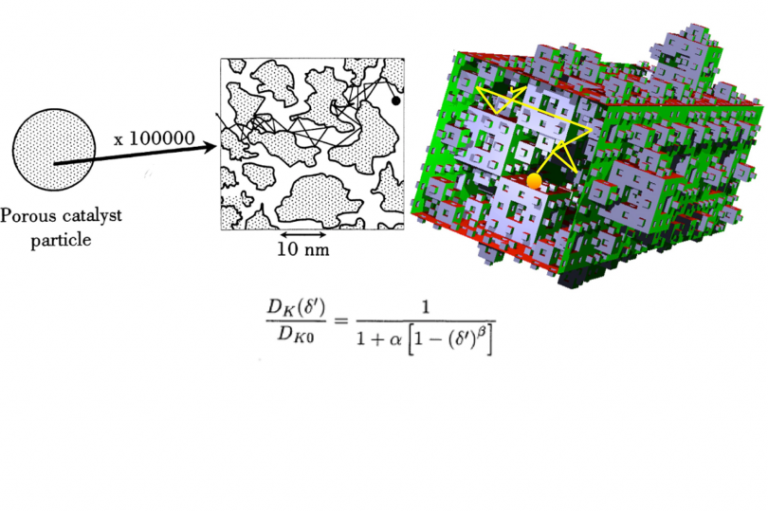The local environment of a catalyst’s active site plays a critical role in determining the catalyst’s activity and selectivity. We study the effect of chemical and geometrical heterogeneity on transport in nanoporous materials, and employ this in catalyst design. We also research nano-confinement effects induced by local curvature, as witnessed in biological systems, and utilize this in the design of supported homogeneous or nanoparticle-based catalysts with improved activity, selectivity and stability.
Inspired by the nano-confinement effects induced by chaperones and other biological nanopores on biological guest molecules, we design and synthesize optimized nanoporous materials as hosts for enzymes, for catalytic or therapeutic applications. These materials are designed with ideal geometrical and chemical surface properties that impart aspects of the desired force balancing witnessed in biological systems.

Current researchers: Nidhi Kapil, Haiyue Yu, Maria Mourkou
Past researchers: Jayesh Bhatt, Michael Nigra, Michele Lynch, Justin Siefker
Collobarators: Synfuels China, Sabic
Key publications
J. S. Bhatt, A. Chutia, C. R. A. Catlow & M.-O. Coppens, 2017. Quantum and statistical mechanical simulations for porous catalyst modelling. Modern Developments in Catalysis (pp. 253-288) DOI:org/10.1142/9781786341228_0008 [Link]
A. S. Perera, P. Trogadas, M. M. Nigra, H. Yu, & M.-O. Coppens, 2018, Optimization of mesoporous titanosilicate catalysts for cyclohexene epoxidation via statistically guided synthesis. Journal of Materials Science. DOI:org/10.1007/s10853-018-2057-2 [Link]
A. S. Perera, J.K. Cockroft, P. Trogadas, H. Yu, N. Kapil and M.-O. Coppens, 2019, Titanium(IV) induced cristobalite formation in titanosilicates and its potential impact on catalysis. J. Mat. Sci. 54, 335-345. DOI:10.1007/s10853-018-2869-0 [Link]
J. Siefker, R. Biehl, M. Krutyeva, A. Feoktystov and M.-O. Coppens, 2018, Connement facilitated protein stabilization, as investigated by small-angle neutron scattering. J. Am. Chem. Soc. 140, 12720-12723. DOI:10.1021/jacs.8b08454 Highlighted in Nature Nanotechnology [Link]
J. Siefker, P. Karande, & M.-O Coppens, 2014, Packaging biological cargoes in mesoporous materials: opportunities for drug delivery. Exp. Opin. Drug Deliv., Ed 11, 1781, DOI:10.1517/17425247.2014.938636 [Link]
D. A. Newsome, S. Gunawan, G. Baron, J. Denayer and M.-O. Coppens, 2014, Adsorption of CO2 and N2 in Na-ZSM-5 –Effects of Na+ and Al content studied by Grand Canonical Monte Carlo simulations and experiments, Adsorption, 20 (1), 157.
[Link]A.J. Dammers and M.-O. Coppens, 2012, Knudsen Diffusion in Finite-Size Channels from a First-Passage Point of View, Soft Materials, 10 (1-3), 369. [Link]
M.-O. Coppens and A.J. Dammers, 2006, Effects of heterogeneity on diffusion in nanopores - From inorganic materials to protein crystals and ion channels, Fluid Phase Equil., 241, 308. [Link]
K. Malek and M.-O. Coppens, 2003, Knudsen self- and Fickian diffusion in rough nanoporous media, J. Chem. Phys., 119 (5), 2801. [Link]
K. Malek and M.-O. Coppens, 2001, Effects of surface roughness on self- and transport diffusion in porous media in the Knudsen regime, Phys. Rev. Lett., 87 (12), 125505. [Link]
- L.-C. Sang, A. Vinu, and M.-O. Coppens, 2011, General Description of the Adsorption of Proteins at Their Iso-electric Point in Nanoporous Materials, Langmuir, 27 (22), 13828. [Link]
- L.-C. Sang, A. Vinu, and M.-O. Coppens, 2011, Ordered mesoporous carbon with tunable, unusually large pore size and well-controlled particle morphology, J. Mater. Chem., 21, 7410. [Link]
- L.-C. Sang and M.-O. Coppens, 2011, Effects of surface curvature and surface chemistry on the structure and function of proteins adsorbed in nanopores, Phys. Chem. Chem. Phys., 13, 6689. [Link]
 Close
Close

